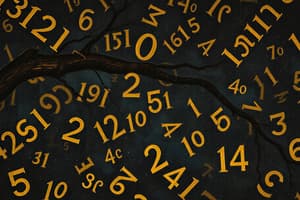Podcast
Questions and Answers
What is the purpose of Euler's Theorem on Homogeneous functions?
What is the purpose of Euler's Theorem on Homogeneous functions?
- To find the sum of series
- To relate the partial derivatives of a homogeneous function (correct)
- To determine integration techniques
- To evaluate limits of functions
Hyperbolic functions relate directly to the circular functions of complex numbers.
Hyperbolic functions relate directly to the circular functions of complex numbers.
True (A)
What is the formula used to find the nth derivative using Leibnitz's Theorem?
What is the formula used to find the nth derivative using Leibnitz's Theorem?
L_n(f, g) = ext{n!} imes ext{C}^{n}_{k} f^{(k)} g^{(n-k)}
The _____ of a matrix is a method to determine the level of independence of the matrix's rows or columns.
The _____ of a matrix is a method to determine the level of independence of the matrix's rows or columns.
Match the following methods with their applications:
Match the following methods with their applications:
Which of the following describes a skew-symmetric matrix?
Which of the following describes a skew-symmetric matrix?
The inverse of a matrix always exists for non-singular matrices.
The inverse of a matrix always exists for non-singular matrices.
What is the main feature of D'Moivre's Theorem?
What is the main feature of D'Moivre's Theorem?
To separate real and imaginary parts of a function, one must typically use the _____ method.
To separate real and imaginary parts of a function, one must typically use the _____ method.
What type of matrix is also referred to as a normal matrix?
What type of matrix is also referred to as a normal matrix?
Flashcards
Complex Number
Complex Number
A complex number is a number that can be expressed in the form a + bi, where a and b are real numbers and i is the imaginary unit, which is defined as the square root of -1.
Expansion of sin^n θ and cos^n θ
Expansion of sin^n θ and cos^n θ
The expansion of sin^n θ and cos^n θ in terms of sines and cosines of multiples of θ. This expansion is helpful to simplify trigonometric expressions and solve problems involving complex numbers.
Powers and Roots of a Complex Number
Powers and Roots of a Complex Number
The process of finding the powers and roots of a complex number. This can be achieved using De Moivre's theorem, which states that for any complex number z = r(cosθ + i sinθ) and any integer n, z^n = r^n(cos(nθ) + i sin(nθ)).
Hyperbolic Functions
Hyperbolic Functions
Signup and view all the flashcards
Logarithm of a Complex Number
Logarithm of a Complex Number
Signup and view all the flashcards
Partial Differentiation
Partial Differentiation
Signup and view all the flashcards
Euler's Theorem on Homogeneous Functions
Euler's Theorem on Homogeneous Functions
Signup and view all the flashcards
Maxima and Minima of a Function of Two Variables
Maxima and Minima of a Function of Two Variables
Signup and view all the flashcards
Successive Differentiation
Successive Differentiation
Signup and view all the flashcards
Matrices
Matrices
Signup and view all the flashcards
Study Notes
Module 1: Complex Numbers
- Prerequisites: Review of complex number algebra, Cartesian, polar, and exponential forms. Statement of D'Moivre's Theorem.
- Topics: Expansion of sine and cosine in terms of sine and cosine of multiples of θ. Powers and roots of a complex number
- Learning Objectives: Understanding of basics of complex numbers
Module 2: Hyperbolic Functions & Logarithms
- Topics: Circular and hyperbolic functions, inverse circular and inverse hyperbolic functions. Separation of real and imaginary parts of functions, logarithm of complex numbers (simple examples)
- Learning Objectives: Understanding hyperbolic functions and logarithms of complex numbers
Module 3: Applications of Complex Numbers in Electrical Circuits
- Topics: Partial differentiation (function of two and three variables, partial derivatives of first and higher order, differentiation of composite functions) Euler's Theorem on homogeneous functions (with and without proof), deductions from Euler's theorem for different variables
- Learning Objectives: Application of complex numbers in electrical circuits
Module 4: Total Differentials, Implicit Functions, and Applications of Partial Differentiation
- Topics: Total differential, implicit functions, Euler's theorem for homogeneous functions with three independent variables
- Applications of Partial Differentiation: Maxima and minima of a function of two independent variables, successive differentiation (nth derivative of standard functions), Leibnitz's Theorem (without proof) simple examples, Jacobian's of two and three independent variables (simple problems), Lagrange's Multiplier method
- Learning Objectives: Comprehending total differentials, implicit functions, and applications of partial differentiation
Module 5: Matrices
- Prerequisites: Inverse of a matrix, addition, multiplication, transpose, symmetric, skew-symmetric matrices
- Topics: Types of matrices (Hermitian, Skew Hermitian, Unitary, Orthogonal Matrices). Properties of matrices (without proof), rank of a matrix using echelon form, reduction to normal and PAQ forms (only 3x3 matrices)
- Learning Objectives: Understanding of matrices and their properties
Module 6: Numerical Solutions of Transcendental and Linear Equations
- Topics: Solution of transcendental equations (Newton Raphson method, Regula-Falsi method), Solution of linear algebraic equations (Gauss Jacobi Iteration Method, Gauss Seidel Iteration Method)
- Learning Objectives: Numerical methods to solve transcendental and system of linear equations.
Studying That Suits You
Use AI to generate personalized quizzes and flashcards to suit your learning preferences.




